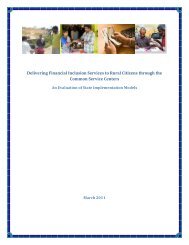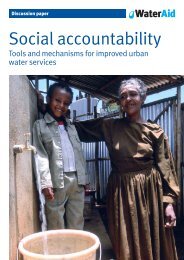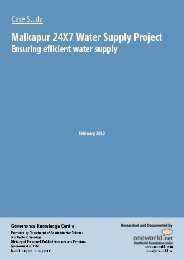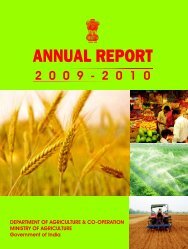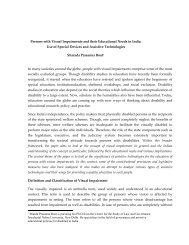Approaching equity - Indiagovernance.gov.in
Approaching equity - Indiagovernance.gov.in
Approaching equity - Indiagovernance.gov.in
- No tags were found...
You also want an ePaper? Increase the reach of your titles
YUMPU automatically turns print PDFs into web optimized ePapers that Google loves.
distract<strong>in</strong>g on its own and would rema<strong>in</strong> <strong>in</strong>completewithout the <strong>in</strong>dicators of socio-political development. Everycitizen <strong>in</strong> India should benefit from economic growth,and its positive effects on development should be felt andexperienced across the nation. Especially, growth has tocater to the needs of the youth of the country. The growthof the country’s economy should lead to more opportunitiesand avenues for the youth and their development.iii. North EastThe ‘one size fits all’ approach of development schemesdoes not serve the <strong>in</strong>tended beneficiaries because of thediverse social and geographic sett<strong>in</strong>gs <strong>in</strong> the North East.Plan schemes should be prepared <strong>in</strong> the context of theregion, its peoples and the current situation of some statesthat are burdened with unrest and political turmoil.iv. ChildrenThe magnitude of the ‘Child Budget’ with<strong>in</strong> theUnion Budget, i.e. the aggregate outlay for child-specificschemes as a proportion of total budget outlay of the UnionGovernment <strong>in</strong>creased to 4.1 per cent <strong>in</strong> 2010-11 (BudgetEstimate) from 3.7 per cent <strong>in</strong> 2009-10 (Revised Estimate).However, if the allocations earmarked for the children <strong>in</strong>the whole period from 2007-08 to 2010-11 are considered,the <strong>in</strong>crease is m<strong>in</strong>iscule <strong>in</strong> 2010-11 (Budget Estimate).The major flagship programmes for the welfare of children– Integrated Child Development Scheme (ICDS), SarvaShiksha Abhiyan (SSA) and the immunisation programmes– depend heavily on external funds. In 2008 – 09, externalaid as a proportion of the Child Budget was as much as 13per cent. These programmes also leave many children out,especially the most vulnerable.The <strong>in</strong>frastructure for child survival, development andprotection rema<strong>in</strong>s weak and <strong>in</strong>adequate. Build<strong>in</strong>gs, staff,and supplies meant for delivery of services are <strong>in</strong>adequateand it is always a case of try<strong>in</strong>g to get more for less. Withrespect to children, sectoral schemes are formulated withlittle attention to the multidiscipl<strong>in</strong>ary needs of the childas a person. Also, a life cycle perspective, cater<strong>in</strong>g to agesprecific needs, is found miss<strong>in</strong>g even <strong>in</strong> <strong>in</strong>tegrated childdevelopment programmes.v. ConflictArbitrary and unequal resource allocations and <strong>in</strong>comedisparities have generated conflicts like Adivasi unrest, casteconflagrations, armed struggles, urban agitations, <strong>in</strong>terstateand <strong>in</strong>terregional disputes. The growth and developmentof the marg<strong>in</strong>alised communities like Adivasis, dalits,m<strong>in</strong>orities, women and the rural and urban poor are badlyaffected as a result. Consequently, growth <strong>in</strong> the monetarysense is not enough. Growth must come with <strong>equity</strong> andproduction with distributive justice.2. Reform of the subsidy regimei. DalitsA general problem with the subsidy regime is that it tends to heavily favour large corporations, <strong>in</strong>frastructure companies and<strong>in</strong>termediaries rather than small traders, consumers and producers. These corporations and <strong>in</strong>termediaries are also out of the reachof Dalits, Adivasis and m<strong>in</strong>orities, and hence social exclusion is re<strong>in</strong>forced. The ‘<strong>in</strong>efficiencies’ of the subsidy regime followed <strong>in</strong> thepast by India have been heavily criticised, specifically by multilateral lend<strong>in</strong>g agencies like the World Bank. These <strong>in</strong>stitutions haverecommended a reduction <strong>in</strong> subsidies <strong>in</strong> order to accelerate growth and remove market distortions. Nevertheless, food subsidieshave cont<strong>in</strong>ued to <strong>in</strong>crease. Food price <strong>in</strong>flation also cont<strong>in</strong>ues.Narrow target<strong>in</strong>g through the Public Distribution System (PDS) has weakened it. A large section of the population still has to buy foodfrom the market, particularly the Dalits, who are landless. Nevertheless, there has been a huge wastage of food stocks rott<strong>in</strong>g <strong>in</strong> theopen <strong>in</strong> Food Corporation of India godowns. Moreover, black market<strong>in</strong>g has made the system prone to leakage. Starvation deathsand malnutrition are on the rise as the food needs of the <strong>in</strong>creas<strong>in</strong>g numbers of the poor are still not be<strong>in</strong>g met.Casteism heavily dom<strong>in</strong>ates the PDS and the Dalits are not only denied access to food but are also made to pay more. Of thetotal 521 villages surveyed <strong>in</strong> five states - Uttar Pradesh, Bihar, Rajasthan, Tamil Nadu and Andhra Pradesh - almost 40 per cent16






